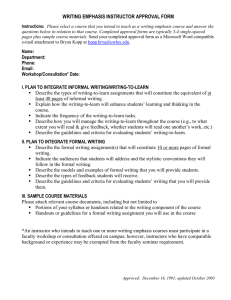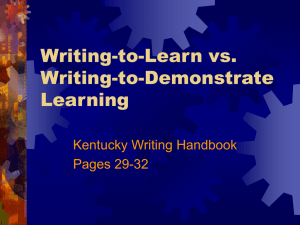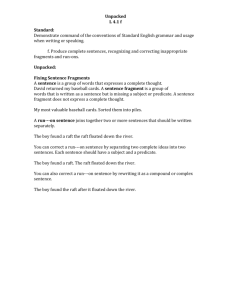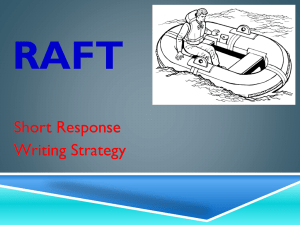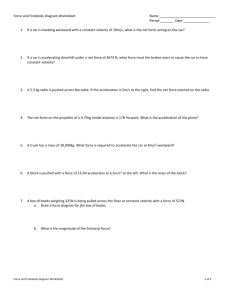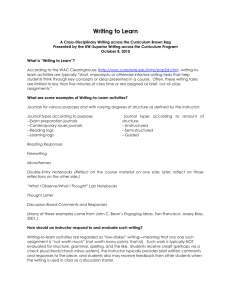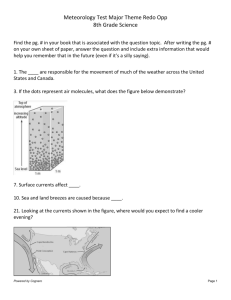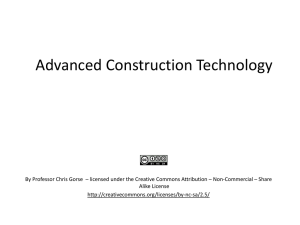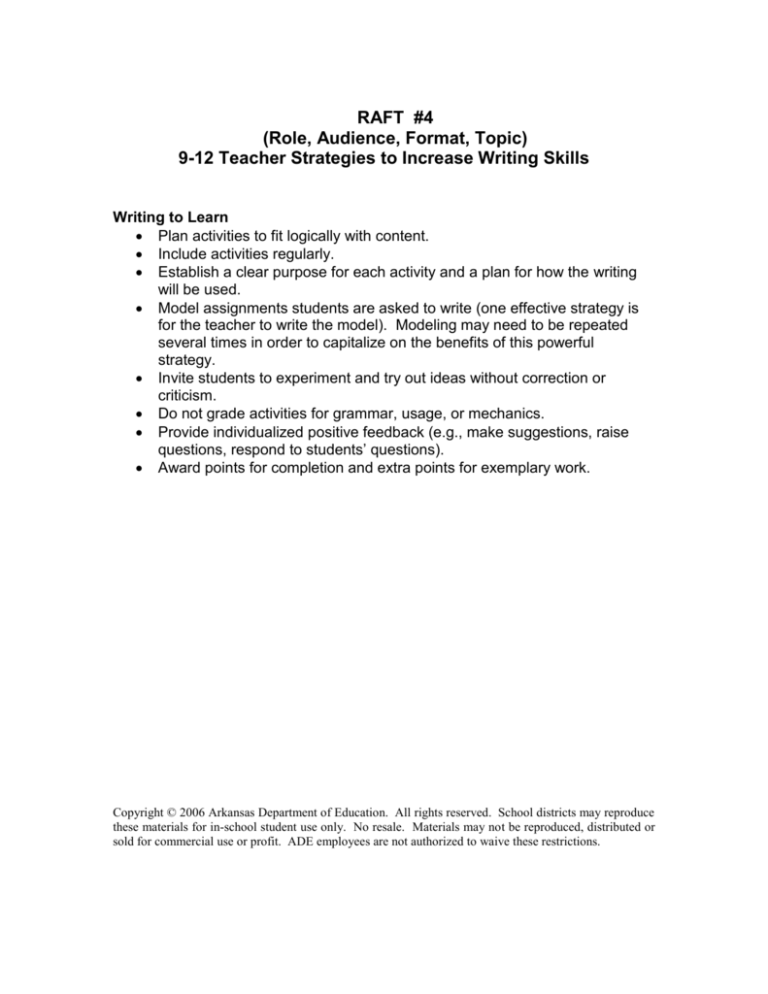
RAFT #4
(Role, Audience, Format, Topic)
9-12 Teacher Strategies to Increase Writing Skills
Writing to Learn
Plan activities to fit logically with content.
Include activities regularly.
Establish a clear purpose for each activity and a plan for how the writing
will be used.
Model assignments students are asked to write (one effective strategy is
for the teacher to write the model). Modeling may need to be repeated
several times in order to capitalize on the benefits of this powerful
strategy.
Invite students to experiment and try out ideas without correction or
criticism.
Do not grade activities for grammar, usage, or mechanics.
Provide individualized positive feedback (e.g., make suggestions, raise
questions, respond to students’ questions).
Award points for completion and extra points for exemplary work.
Copyright © 2006 Arkansas Department of Education. All rights reserved. School districts may reproduce
these materials for in-school student use only. No resale. Materials may not be reproduced, distributed or
sold for commercial use or profit. ADE employees are not authorized to waive these restrictions.
Writing Instruction
Essential Element Writing
Framework Refer to box below
Type
Writing-to-learn
W.5.9.8, W.5.10.8, W.5.11.8, W.5.12.8,
W.5.9.9, W.5.10.9., W.5.11.9, W.5.12.9
Example
Journals, learning logs, writer’s
notebooks, exit and admit slips, inquiry
logs, mathematics logs
SREB Literacy Across the Curriculum
Rationale
Although neglected by both literacy and content area teachers, writing-to-learn is
an important tool for several reasons. When writing-to-learn activities are used
appropriately, students engage more fully; they develop critical thinking skills and
they become more aware of their own learning processes. To be effective,
learning must be active, and writing encourages students to become active
learners. Writing-to-learn leads to deeper understanding and more permanent
retention of information. It offers students a means to clarify their thinking, and it
provides teachers a means for quick, informal assessments that can inform
instruction.
Note: In order to meet the needs of diverse learners less complex materials can
be employed to accommodate the needs of Tiers II through V students. (See
‘Strategies for Teaching Writing Skills to Tier III, IV, & V Students’). It should not
be assumed that students who struggle with writing cannot use adapted
materials with the graphic organizers and other ideas presented here.
Writing-to-learn activities are immense in variety and can be used effectively at
the beginning, middle, and/or end of a lesson or unit of study. Because they are
often short and can be quickly assessed, teachers are able to provide immediate
personal and positive feedback. These activities also encourage frequent use,
and writing frequently is more beneficial to learning than traditional long writing
assignments given infrequently. When writing-to-learn activities are assessed
without consideration of grammatical or mechanical concerns, students develop
greater fluency and are more willing to take risks and experiment with new ideas.
The purpose of this kind of writing is for students to capture ideas and to connect
personally with what they read and study.
Materials
Short pieces of engaging text, informational or narrative. Tiers II through V
students may need a tape recorded version of the text. Note: In several
of the activities which follow, sample pieces of text have been included.
Writing-to-learn activities should be designed for use with the whole class
or with small groups. These activities may be implemented at the
beginning, middle, and/or end of instruction; some require as little as two
or three minutes; others may take more time, depending on how much of
the writing process is included. Writing-to-learn activities may usually be
assessed as rough drafts, but several may become the basis of more
extensive alternative assessment. Teachers can easily determine when
to introduce revising, editing, and publishing. All of the following activities
can be found in Tools for Teaching Content Literacy by Janet Allen or in
Smart Step/Next Step Strategies for the Content Areas produced by the
Arkansas Department of Education.
Direct Instruction
The teacher will explain and give examples of how writing helps students
to clarify their thinking and remember what they have learned (grocery
lists, e-mails, text messages, memos, class notes, etc.). S/he will
emphasize that writing helps learners become more active and allows
them to take more responsibility for their own learning. The teacher will
explain how writing-to-learn allows the student to discover, organize and
retrieve information more effectively and will illustrate a variety of tools that
can be used for writing-to-learn (journals, learning logs, graphic
organizers, etc.)
Modeling
Many of the writing-to-learn activities that follow include samples of text,
graphic organizers, and possible responses that can be used to model the
strategy. Regardless of whether the activity is very short or more involved,
the teacher should work through the activity so that students understand what
quality responses should look like. Thinking should be made visible on chart
paper, at the board or on the overhead projector. In some cases, the teacher
should model the strategy several times with different pieces of short text.
Guided Practice
All of the writing-to-learn activities that follow allow students to practice what
they have seen the teacher model. These activities encourage frequent
writing, with the student rather than the teacher as the audience. Most can be
done collaboratively or independently; all require teacher feedback so that
students perceive the benefit and continue to engage fully. These guided
practices afford the teacher the opportunity to assess understanding quickly
without the necessity of evaluating grammar and mechanics.
Application
Several of these activities lend themselves to more fully developed writing
assignments that afford the opportunity for creative expression. As students
become more secure with these strategies, they may then be able to design
their own assignments. For example, when students initially use the RAFT
activity, the teacher must supply the role, the audience, the format and the
theme choices. As they become more confident, students may be able to
originate their own options. Also, many of the strategies invite more
extensive development through the writing process; what started as a quick
response to learning may become a fully developed writing assignment that
includes all aspects of the process.
Copyright © 2006 Arkansas Department of Education. All rights reserved. School districts may
reproduce these materials for in-school student use only. No resale. Materials may not be reproduced,
distributed or sold for commercial use or profit. ADE employees are not authorized to waive these
restrictions.
Writing-to-Learn Activities Rationale
(from “Smart Step/Next Step Strategies for the Content Areas”)
These writing-to-learn activities may be appropriately used before, during, or
after class. They offer a variety of benefits by:
Promoting engagement.
Enhancing understanding of concepts being studied.
Promoting thinking.
Encouraging writing daily.
Providing insight into students’ thinking processes.
Offering the opportunity for quick assessment and for personal, positive
feedback.
Guided Practice
Choose appropriate times before, during, and/or after learning to include
writing-to-learn activities.
1. Plan to use the work produced in these activities in a meaningful way so
that students perceive their benefit and value.
2. Evaluate work as rough drafts and encourage students to take risks in
their responses.
3. Provide personal and positive feedback to all or to selected papers.
4. Consider awarding points for satisfactory completion and rewarding
exemplary work with extra credit.
Develop a systematic plan for offering feedback.
RAFT #4
(Role, Audience, Format, Topic)
RAFT, an acronym for Role, Audience, Format, and Topic, is a writing-tolearn strategy that leads students to think critically and creatively about the
content which they have studied. This strategy offers several benefits:
It is useful in any content area after students have read, viewed, or
studied a concept or event.
It engages students who do not respond to typical academic
assignments.
It provides support in critical areas of reading and writing.
It leads students to make personal connections to what they have
studied.
It asks students to infer and to predict from text clues.
It promotes the synthesis of newly acquired information into an
imaginative piece of writing.
It adapts easily to individual or to collaborative work.
It offers a means of alternative assessment.
Materials
Each student needs a copy of a passage of text (one that you
provide or a passage selected from your textbook).
A list of options for their responses. (See “What Every Freshman’s
Parents Should Know” and the “RAFT Options Grid” for samples to
use as you model.)
Guided Practice
1. Have students read the text.
2. Determine whether students will work individually, in pairs or in small
groups; then organize the class accordingly.
3. Distribute the “RAFT Options Grid” that relates to the text and discuss the
writing tasks. Lead students to understand that they will select/be
assigned a role such as “12-year-old brother.” In the role of 12-year-old,
the writer will be addressing “his friend,” who is the audience. Discuss
how these boys would speak to each other, what vocabulary they would
use, etc. Next, lead them to look at the format of the writing they will
produce, for example, a short “two-character play,” and consider the
conventions that are appropriate for this form. Finally, examine the theme
that will be portrayed in the play—“no money for allowance or treats.”
Consider how the theme affects the tone of the piece.
4. Allow time for students to draft their responses. In this modeling activity,
you may allow shorter responses in rough-draft form. If you use this
activity for a more formal alternative assessment, you may lead students
to craft, revise and edit more thorough responses.
5. Provide in advance a rubric, you design, for assessing student work.
Assessment
Discuss with students how variations in role, audience, format or theme
affected their choices and the product which they created. Assign credit to
completed work. Provide time for students to share their work either orally in
small groups or more formally after they have opportunity to revise and edit.
See rubric.
Tier II Additions
Arrange for student to work with a strong student peer or in small
group.
Assign student a less complex writing example, such as an
advertisement to represent the reading.
Allow student to respond to only 3 out of the 4 categories on the
RAFT Guide.
Tier III Accommodations/Modifications
Arrange for student to work with a strong student peer or
paraprofessional.
Assign student to write an e-mail message to explain the text.
Allow student to respond to only 2 out of 4 categories in the RAFT
Guide.
Tier IV Modifications
Allow student to respond to only 1 out of 4 categories in the RAFT
Guide and dictate answers to a student peer, teacher, or
paraprofessional.
Tier V Modifications
Provide a tape recorder for student responses to the R category of
the RAFT Guide with the help of a student peer, teacher, or
paraprofessional.
Copyright © 2006 Arkansas Department of Education. All rights reserved. School districts may
reproduce these materials for in-school student use only. No resale. Materials may not be
reproduced, distributed or sold for commercial use or profit. ADE employees are not authorized
to waive these restrictions.
What Every Freshman’s Parents Should Know
(Reading Example for RAFT)
The real coast of sending a kid to college goes way beyond tuition
Your oldest child starts college this fall? Congratulations! You’ve been
bracing for the tuition bill for years. Now it’s time to consider costs no one has
mentioned before—like extra-long twin sheets for the dormitory mattress, a good
cell-phone plan and on-campus health insurance.
Many first-time college parents don’t think about these additional
expenses until August—a little too late for comfort. “After your kid is accepted,
you become very calm,” says Jill Fraser, the mother of a junior at the University
of Pennsylvania. “It can take too long before you realize this isn’t like sending
him to summer camp.”
Indeed, it isn’t. In the 2003-2004 academic year, miscellaneous costs—
not including books, supplies, college fees and transportation—averaged $1,637
for resident students at four-year public colleges and $1,183 for those at fouryear private colleges. And parents and students say those estimates are
conservative.
You’ll spend at least $300 just furnishing the dorm room, says Ilene Perl,
the mother of a recent graduate and a Wesleyan junior in Connecticut: “You
don’t have room in the car for everything he needs. So you arrive on campus
and immediately start shopping—for a lamp, a rug, a wastebasket, a fan, storage
bins, cushions, a mini-refrigerator, groceries.”
On the first day of freshman year, it’s always either extremely hot or raining,
and tension runs high. A few advance phone calls will save you frustration and
money.
Find out the distance from the parking lot to the dorm entrance. Will
there be volunteers to help freshmen move in? If not, bring a dolly.
Ask what roommates will bring, to avoid duplication.
Ask if the college has summer storage and what it costs. You may be
better off renting a mini-refrigerator and a microwave than buying and
hauling them home every year.
Ask if the dorm furniture is movable. If so, bring bed lifters—heavy-duty
plastic or cinder blocks—to create under-bed storage space. “Dorm
dressers have tiny little drawers, and your kid will bring 20 sweaters,”
says Laura Licata, the mother of a Muhlenberg College senior and a
Union College graduate.
And Don’t Forget:
Activity fees. Buy an activities pass, advises Betsey Taggart, the mother
of two sophomores at Brigham Young University. “For $70, the pass gave
admission to every sporting event of the season.” Be warned: Extracurricular
activities—from joining an a cappella singing group to playing on the ice hockey
team—involve extra costs for special clothing, equipment and travel. “I was
shocked at the cost of joining a sorority--$700 upfront, plus about $500 per
semester,” says Roy Cohen, the father of a recent Arizona State graduate.
Health insurance. You must buy student coverage unless your child is
already insured. She probably is, if you have comprehensive group health
insurance. Most plans cover full-time students up to age 22 or older.
Travel costs for kids far from home. “We figured on round-trip airfare
three or four times a year,” says Donna Shear, the Evanston IL, mother of a
senior at Columbia University in New York. “But we didn’t foresee the cost of her
holiday train trips to visit East Coast friends and relatives.”
Parking fees, gas and car maintenance. Parking can be costly. There
are more cars on campus than space for the, says Susan Maxwell, the mother of
a senior at the University of Southern California. “And many kids drive home
rather than fly,” she adds.
Food. No matter what meal plan you buy, your kid will eat outside the
plan: Picky eaters hate meal-plan food; indiscriminate eaters are often hungry
more than three times a day.
Books and supplies. Books cost $400-$500 per semester. If your child
is an art major, you’ll also spend a small fortune on project materials, says Lynne
Rankin, the other of a Wellesley graduate.
A cell phone. Dorm phones are expensive for off-campus calls, says Ron
Roge, the father of a Bryant College graduate. If you have a cell phone, ask if
your provider has a family plan, advises Illene Perl. But if your child is going to
college across the country, don’t sign up for cell service until you arrive on
campus, warns Donna Shear. “Our Illinois provider turned out to have spotty
service in New York.”
Spending money. Many parents expect kids to earn their own. But for
travel, online purchases and emergencies, many give their child a credit card on
their own account—with strict instructions to call every time he uses it.
Packing for Freshman Year of College
Recent College Grads Say
Bring flip flops for the communal bathrooms.
Bring a jar full of quarters for laundry.
Install anti-virus software on your computer.
Experienced Parents Say
Bring a few screwdrivers to assemble new equipment.
Pack items in plastic trash bags. They’re lighter to carry.
Throw in three weeks’ worth of socks and underwear. It will be at least
that long before your kid does a load of laundry.
RAFT Guide
Role
Audience
banker
Form*
loan application
12-year-old
brother
his friend
2-character play
business man
college freshmen
advertisement
college freshman
mother
phone call
elderly
grandparent
college senior
college freshman
lecture
college freshman
e-mail message
mother
her friend
gossip session
father
Topic
money for child’s
college expenses
no money for
allowance or
treats
products available
to freshmen
request for more
money
kids today are
spoiled
how to manage
money
what she has
bought for her
student
*Accommodations for Tiers II through V can easily be made by selecting the
appropriate form. For example, writing a 2-character play is much more complex
than writing a script for a phone call.
RAFT Rubric
(Tiers
I through V)
Your RAFT assignment will be evaluated on the following
criteria:
Completion
1
2
3
4
Accurate Information
1
2
3
4
Appropriate Audience
1
2
3
4
Appropriate Format
1
2
3
4
Grammar/Mechanics
1
2
3
4
Neatness
1
2
3
4
Creativity
1
2
3
4
Copyright © 2006 Arkansas Department of Education. All rights reserved. School districts may reproduce
these materials for in-school student use only. No resale. Materials may not be reproduced, distributed or
sold for commercial use or profit. ADE employees are not authorized to waive these restrictions.

